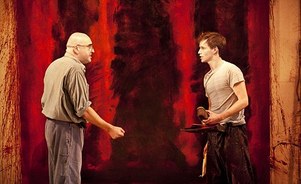
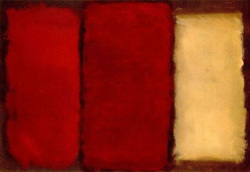
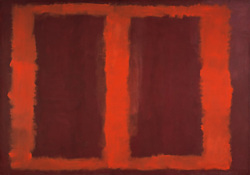
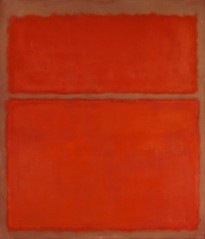
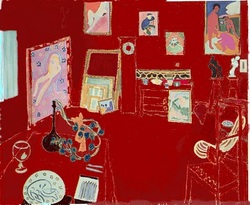
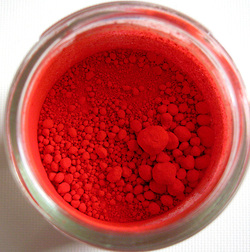
If you're interested in color you'll like this blog, full of information about colors, pigments, history, and uses http://artists-pigments-index.blogspot.com/
What does color mean to you? What color defines YOUR life?
| artsmarttalk.com |
|
 Mark Rothko, as presented in the play RED, is irascible, self-centered and selfish, in love with his own opinions, domineering .... the justification for such a personality looms over audience and players, the large RED painting meant to represent Rothko's actual work. When I saw RED (the play) recently, I found it to be meaningful but not as compelling as I had expected, partly because I thought the actor playing Rothko didn't have enough gravitas for the role. I'd like to see it again, with another actor, to see what it would be like. (the photo is from the NY production with Al Molina, which got rave reviews - not the one I saw)  But that's ART, whether on the stage or on canvas. Rothko did miraculous things with the color red, but the same color is scrawled across handmade valentine cards and schmaltzy paintings of sunsets. The difference (noted in the play) is significance. One artist picks up a brush, a pencil, a piece of paper or cloth, adds a few bits of color and creates an object that stirs deep in the soul and moves you to reverie or to tears; another makes a painting that goes well with the sofa. The glory and the frustration of being an artist is striving for significance and always fearing you'll just end up over the sofa.  RED features a series of paintings - a 'mural' that was commissioned from Rothko by Philip Johnson, architect of the iconic Seagram's Building on Park Avenue in New York, to be placed in the high-style Four Seasons Restaurant. Rothko was paid a great deal of money and set to work, but somewhere along the line he apparently became to fear the 'sofa' problem (the play centers his doubts in a studio assistant who challenges his motives but the true reason is unknown) - he returned the money and refused the commission. The 30 paintings he did for the commission, however, remain to testify. (Some are at the Tate Modern, some in Japan and elsewhere)  Rothko was known for his 'pickiness' - his insistence on proper lighting (very dim) and placement, and when 'he' explains on stage that he can't allow his work to be trivialized as a backdrop for the clank of silverware and the empty prattle of rich diners, it rings true. There is a spirituality about Rothko's work that resonates deep and long with profound significance - it's no surprise that one of the most successful installations of his work is in a specially built Chapel in Houston.  Red, of course, was not his only color, but it spoke a language that he understand like few others. The great painting Red Studio by Matisse, a supreme master of color, is mentioned in the play - another monumental use of this rich complex color. There is also word play with a litany of red shades and hues that is one of the delights for any painter - "cadmium, vermillion, alizarin...." Red has a myriad of variations, some deadly in pigment form.  10 years after we see him in the play, in February 1970, Rothko killed himself in his studio. His life and work, and then death, were defined by color - the colorful reds had gradually disappeared over that decade, replaced finally by dark, heavy blacks, mud browns, and greys. If you're interested in color you'll like this blog, full of information about colors, pigments, history, and uses http://artists-pigments-index.blogspot.com/ What does color mean to you? What color defines YOUR life?
4 Comments
 I was inspired to focus this post on Design by Ross Douthat's recent NY Times essay about Steve Jobs. Douthat's tribute, among those I saw and read, was the only one to mark out Jobs for his contribution to Design - while he was, of course, also reinventing our entire lives. The article points out Job's "eye for grace and style, and his recognition of the deep connection between beauty and civilization." http://www.nytimes.com/2011/10/09/opinion/sunday/douthat-up-from-ugliness.html?_r=1&ref=rossdouthat  There it is - the crucial factor that is so easily overlooked. We live better, think better, and create more positive versions of ourselves when we recognize that beauty is essential to our lives. Jobs himself said of design, “In most people’s vocabularies, design means veneer. It’s interior decorating. It’s the fabric of the curtains of the sofa. But to me, nothing could be further from the meaning of design. Design is the fundamental soul of a human-made creation that ends up expressing itself in successive outer layers of the product or service.” 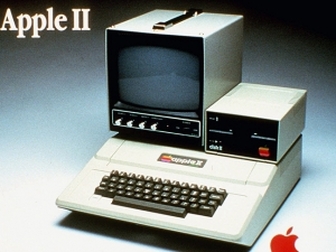 Jobs held 317 patents for Apple products. They range across categories: computers, mice, monitors, but also the staircase in Apple stores and a clasp for a pair of cords. An interactive timeline from the NYTimes gives the idea. Not all Not all are 'beautiful' but you can see how he moves over the years from the first typewriter with a tv and a box (1977) towards sleek, graceful forms that have an inevitable relation to function. http://www.nytimes.com/interactive/2011/08/24/technology/steve-jobs-patents.html?ref=business  They work - astonishingly so at times - and, especially from the last 10 years or so, the designs are truly beautiful. A user interacting with an iPhone is beauty in action - form and function in harmony, with an extra measure of very cool pleasure. There are some Jobs products that didn't make it but now they don't count because no one remembers them. The rule of good product design can be defined as 'looks good' 'works well' and 'sells well' - if all three aren't there, the product won't survive. The blog Architecture + Morality puts forth this tenet in a post about design: 'most people believe that good ideas should continue, while bad ones should be laid to rest. Usually the market filters out the real stinkers.." http://architectureandmorality.blogspot.com/2005/11/some-things-are-better-when-theyre.html  Steve Jobs is listed as 'artist' in the database of the Museum of Modern Art: a number of his designs (some in collaboration with others) figure in the permanent collection. His true nature, as characterized in one of many tributes, was that of Leonardo da Vinci, rather than the more straightforward genius of Einstein. As for Leonardo, for Steve Jobs the metaphorical box was for other people - he was always out beyond, dreaming up what was next going INTO that well-designed box with the immortal logo. Here are a few examples of contemporary product design. What do you think? Which are good enough to survive? Leave a comment - which one(s) and why? I'll publish the answers next post!  There's a lot of art to see in Old City Philadelphia, but currently there are two shows that stand out. In medium and execution they're at opposite ends of the spectrum, but if you're interested in thoughtful, careful work by sophisticated professional artists, you should see them both. Dust and Shade, Drawings by Charles Ritchie, at Gallery Joe, brings you into a quiet, small-scale world of finely observed detail. Ritchie has 4 sketchbooks in the show - see them first, and you'll understand a lot about his approach. His rich delicate watercolors and tiny spidery handwriting bring to mind 19th century Victorian sketchbooks, but when you examine the framed drawings on the wall you see that he brings the same detailed awareness of the possibilities of the ordinary to his finished work. 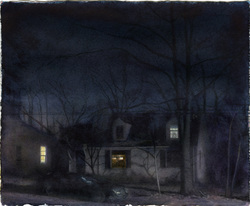 A dark night, a suburban house under a streetlight, a scrim of bare branches - this is Ritchie's touchstone. The same quiet neighborhood (his own, in Maryland) figures in many of the works. There is a suggestion of eternal fall, but then comes a scene with snow - the white mounds feel inevitable, as if they're guarding the house through the winter. Subtle tricks with the light and shadows give a slightly surreal feeling and bring to mind Magritte's painting, Empire of Light. 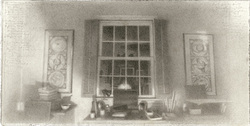 Interior scenes are soft, graphite stills of life interrupted for just a moment, but look closely and watch the tiny spidery handwriting emerge around the edges. You're back to Ritchie's sketchbooks and his gift for detailed observation of life as it happens. 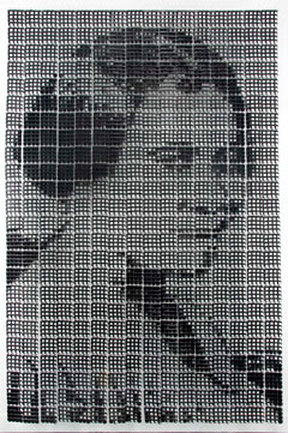 Snyderman-Works Gallery, an extraordinary, impeccable place that has been championing fine art/craft for almost 50 years, is showing Sonya Clark's deeply intelligent mixtures of craft, art, history, and tongue-in-cheek humor. Like Ritchie, has a touchstone in the ordinary, but for her it's not the romance of a familiar neighborhood, it's the edgy duality of a simple plastic comb. The stunning centerpiece of the show is a wall-hanging portrait of the African-American entrepreneur C. J. Walker, who, in the late 1900's, made a fortune with hair products, including one that helped prevent scalp disease. From a distance it appears photographic, perhaps an extreme enlargement of a daguerrotype, or even a cut paper silhouette, but in reality it is made of hundreds of the banal black plastic combs that figure in many of Clark's works. For this portrait she manipulated her medium, breaking out teeth and crisscrossing the combs to give her a surprisingly fluid vocabulary. 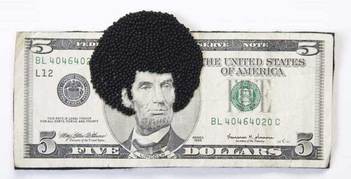 Hair, real or imitated with yarn, is at the heart of the work on display. Some examples are blatantly humorous - Abraham Lincoln on a 5 dollar bills sports a 70's era Afro - but peel back the layers and you'll find the Emancipation Proclamation, the plight of freed African slaves newly dependent on making an elusive, money-driven living, etc - to the present day. 'Diaspora' appears fairly simple at first too - tiny white canvas squares, each with a long tail of dark braid, cluster on a wall, but watch and think and you almost see them start to move, for escape or betterment, and leaving trails of identity and tears. 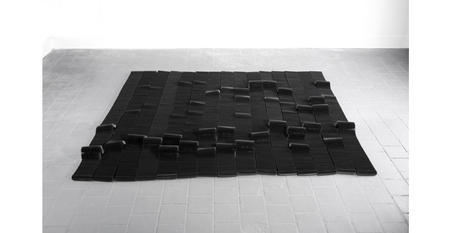 I was especially struck by 'Comb Carpet' a dark square that is, as it states, made of combs pointing their little spikes upward. It looks like black Astroturf, but as you imagine yourself settling down for a picnic or a nap, you feel the jabs and notice the ripples that disturb the surface. No easy seat this - this is history in subtle, pointed relief. Clark's work is significant - the show at Snyderman-Works is her first one-person show in Philadelphia. Dust and Shade, Drawings by Charles Ritchie is at Gallery Joe through October 22.
Sonya Clark is at Snyderman-Works Gallery until November 19. Note: Old City Philadelphia is gritty, lively, edgy, exuberant - a perfect place for the battery of energetic art galleries, studios, hip little shops, and brash neon bars that defines it. First Friday in Old City is, month after month, the best city art party I've ever seen. If you haven't been to it, you're invited, so go! 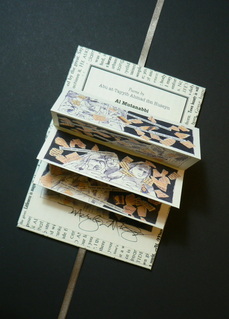 'The Best Companions are Books Alone' open I usually write about other people's art on this blog, but this time I want to share a project I've been working on. It's a book - handmade, hand-bound, with prints of original drawings - and I'm doing it as part of a world-wide movement called the Al-Mutanabbi Street Coalition. The background: There was once a great Arabic writer named Abu at-Tayyib Ahmad ibn Huseyn. Born in the 10th century, he was the son of a water carrier, a born revolutionary, and a court poet for an Arab Prince. His nickname, Al-Mutanabbi, means 'the would-be prophet.' He was eventually killed, perhaps because, in a poem, he insulted a powerful man. For centuries the Baghdad street named after him was the center of intellectual life, with books and booksellers everywhere, and cafes buzzing with lively literate discussions. 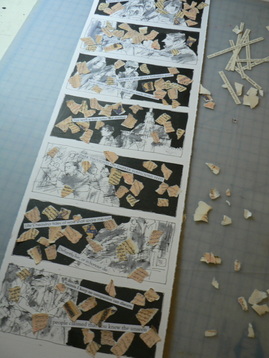 in progess. Collaging shreds to the drawings But then came March 5, 2007, and life on Al-Mutanabbi Street was blown to bits by a car bomb. More than 30 people were killed, more than 100 wounded - and the heart of literate Iraq was dealt a death blow. Or at least that was the intent. Kill ideas, kill thought, kill expression - it's a rusty old weapon in the violent arsenal of control and oppression. Al Mutanabbi Street reopened for business in 2008, but no one can think it will easily return to normal. For several years, The Al-Mutanabbi Street Coalition has been working to counter the destruction of books, ideas, intellectual pursuits, literary accomplishment, and the dignity of the Iraqi people. The organizers, Beau Beausoleil and Sarah Bodman, have been gathering letterpress printed broadsides and artist books, giving talks, presenting exhibits, and in many other small and large ways, keeping the spirit of Al-Mutanabbi Street alive. 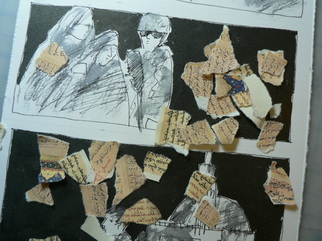 drawing for 'The Best Companions are Books Alone' in progress I'm told that some early submission were focused on war. I hope mine won't be seen as war-focused, though it is impossible not to have that idea hovering nearby. I purposely chose images from daily life, including a sketch of Al-Mutanabbi Street before the blast, along with a mosque, women on the street, men in a cafe - and an American soldier, because that has also been, for too long, part of daily life there. I could not get the image of all that tragic but beautiful Arabic confetti showering down after the bomb went off out of my mind, so I've made that important. 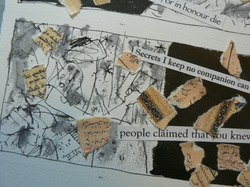 Drawing of the Abbasid Court where Al-Mutanabbi worked and lived in the 10th c. The cover text and text across the images are English translations (by Nancy Coffin) of Al-Mutanabbi poems - beautiful language but much of it chillingly prescient about harm and violence. (The title, ‘The Best Companions are Books Alone’ is a quote.) make the I reduced the size of the images when I printed them before I folded them into the accordion - I wanted to make the book something that could be hidden in a pocket if necessary. 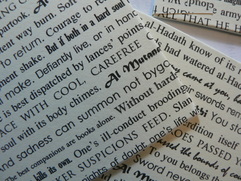 My book is one of three I'll send them - along with the others, one of mine will be donated to the Iraqi National Library in Baghdad. The other two will become part of the exhibits and displays. Read Beau Beausoleil's description of the Al-Mutanabbi Coalition project here: http://www.scribd.com/doc/36553491/An-Inventory-of-Al-Mutanabbi-Street If you'd like to see more of my hand-made artist books visit my website and on-line store - click here http://www.marilynmacgregor.com/artist-books.html all images and book ©Marilyn MacGregor 2011 |
Share ArtSmartTalk
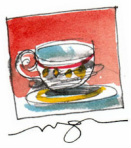
MacGregor-Art.com Cards and art gifts with a Fine Sense of Fun Also at http://www.etsy.com/shop/MacGregorArt ArtSmart Consulting
|
| Blog: |
| ArtSmartTalk |
Topics: |
| Art History, Design, Art |
All
19th C Art4a3f8ec7db
20th C59300e1f29
African Art
Almutanabbi Streetbb1c3786e2
American Art
Ann Hamilton
Apple
Apple Computers
Arabic Poetry
Architecture
Art
Art And Nature
Art And Technology
Art As Collective Memory
Art Auctions
Art Books
Art Forgery
Art Galleries
Art History
Art In Gardens
Art Installation
Art Installations
Art Licensing
Art Of Spain
Art Prints
Art Technology
Baghdad Books
Barnes Collection
Biennial
Book Project
Books
Brooklyn Museum
California Design
Chelsea Galleries
Chess
Color
Constable
Contemporary Architecture
Contemporary Art
Contemporary Design
Design
Detroit Institute Of Arts
Drawing
E H Shepard
El Anatsui
Etching
European Art
Expressionism
Fabric Design
Flags
Folk Art
French Art
French History
French Portraits
Galleries
George Bellows
Goya
Goya Black Paintings
Goya Portrait
Hand-made Books
Historical Art
Hokusai
Ho Tanner
Illustration
Installation Art
Iraq
Jean Clouet
Lacma
Lewis Chessmen
London
Los Angeles
Mac Computers
Mary Cassatt
Matisse
Met Museum
Metropolitan Museum
Metropolitan Museum Of Art
Modern Art
Modern British Painting
Moma
Moma Ps1
Moons
Museums
Napoleon
National Gallery
Nature
New Architecture
New Art
New Design
New Goya Painting
New York
New York Art
Norse Art
Novels About Art
Old City Philadelphia
Online Art Sites
Outdoor Art
Outsider Art
Painting
Paris
Pat Steir
Performance Art
Philadelphia
Philadelphia Art
Philadelphia Museum
Photography
Plein Air
Portraits
Product Design
Red
Religious Art
Rembrandt
Rome
Rothko
Royal Portraits
Sarah Sze
Scottish Art
Self-portraits
Significance Of Art
Sketching
Southern California
Soutine
Spanish Art
Spanish History
Steve Jobs
Technology
Thanksgiving
The Importance Of Art
Turner
Van Gogh
Velasquez
Venice Biennale
Whitney Museum
Words And Art
Young Artists
August 2013
May 2013
February 2013
January 2013
December 2012
November 2012
October 2012
September 2012
August 2012
July 2012
June 2012
May 2012
April 2012
March 2012
February 2012
January 2012
December 2011
November 2011
October 2011
September 2011
August 2011
July 2011